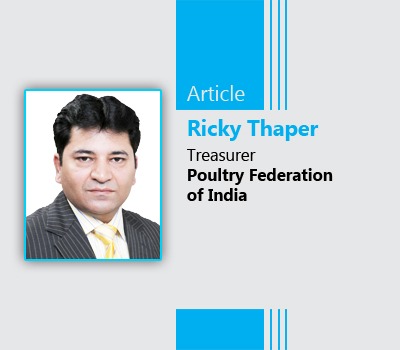
With Domestic Demand for Frozen and Chilled Poultry Products going up, Coupled with New Export Opportunities, Indian Poultry Industry needs to step up with adequate Processing capacity meeting International Norms
– Ricky Thaper, Treasurer, Poultry Federation of India
India’s poultry industry is today one of the fastest growing poultry producers in the world with production having grown four-fold over the last two decades. The shift has been gradually to large-scale commercialization, overcoming several challenges on the way. According to the National Action Plan for egg and poultry – 2022 prepared by Department of Animal Husbandry, Dairying and Fisheries, more than 80% of poultry output, particularly in the broiler segment, is today produced by organized commercial farms. Major poultry companies have vertically integrated operations which comprise 60-70% of the total poultry meat production. Thus, India has emerged as the world’s third largest egg producer and sixth largest producer of broiler meat.
The poultry sector is growing at a compounded annual growth rate (CAGR) of 10.5% and playing a critical role in promoting livelihood options in rural India. Instead of rearing country birds, farmers are now increasingly rearing hybrids which yield better operating parameters and sustainable profits. Rising urban population, changing eating habits and growing penetration of quick service restaurants have all played a big role in sustaining growing demand for poultry meat. According to Basic Animal Husbandry Statistics, 2020, India’s poultry meat production was 4.34 million tons, contributing more than 50% of the total meat production in 2019-20. The egg production stood at 114.38 billion in 2019-20. The global poultry market is expected to grow at a compounded annual growth rate (CAGR) of 10.1% to touch $350.87 billion in 2022 from $318.58 billion in 2021. By 2026, it is expected to touch $493.21 billion, growing at a CAGR of 8.9%.
Poultry consumption is expected to grow maximum in the coming years. However, we need to acknowledge that poultry processing and value addition is still at a very nascent stage in India. The share of processed chicken meat industry is only around10% of the overall industry. This is due to the consumer preference for the live bird. This dominance of wet or live bird market limits geographical movement of output given the perishable nature of the product and limited cold storage and transportation infrastructure. The impact of our limited processing capacity is also reflected in our poultry meat exports.
As per Agricultural and Processed Food Products Development Authority (APEDA) data, in 2020-21, India exported 2,55,686 tons of poultry products valued at Rs 435 crore ($ 58.7 million). Traditional export destinations have been Oman, Maldives, Indonesia and Vietnam. Though both the quantity and value of the exported processed poultry products have increased during the last few years and efforts have been made to increase poultry exports from India, the trade is very small in comparison to the global trade. The global poultry market is expected to grow to $493.21 billion in 2026 at a CAGR of 8.9%. Exports are not equitable across the globe and are concentrated in certain clusters like, Middle-East and South-East Asia.
Recently rise in demand for chicken from Singapore following the ban on exports by Malaysia could not be utilized for promotion of exports from India. Given that Singapore imports 34% was met by Malaysia alone, this can be a godsend opportunity to make further inroads into the Singapore market. Frozen chicken from the South American nation accounts for 48% of the total imports by Singapore. The US supplies 8%, while a few smaller exporting nations make up the rest 10%.
While there is a good scope of export of dressed chicken to Singapore from India and a few companies from South India which have poultry processing plants, are already in the process of exports to the island nation, we need to step up our export capacity. Value-wise, our current chicken exports are much lower compared with exports from Brazil and the US.
To do this, Indian exports need to be competitive in terms of costs as well as quality. Export viability depends on competitive cost of production and proximity to international markets. Indian chicken exports have faced difficulty in the international market because there is no low pathogenic avian influenza (LPA) vaccination. Only in December last year, the United Arab Emirates lifted a ban on importing eggs and other poultry products from India after the Indian government gave an assurance that Indian poultry meat exports would adhere to bio-safety norms prescribed by the World Organization for Animal Health to prevent infection from bird flu.
We need to create infrastructure for slaughter house for boosting out exports. We need to have adequate processing facilities which meet international standards. The cost of the production for poultry bird is expensive compared to other countries such as Indonesia, Philippines and China. The high input costs are a major reason for this. Cost of production of our feed is higher compared to other countries such as the US, China or Brazil. Feed price constitutes around 70% of the total production cost. This apart, the seasonal nature of consumption leads to volatile demand supply trends across regions, making all calculations go awry.
Developing efficient distribution with large investments in cold chain infrastructure and proper high-capacity processing plants of international standards is the need of the hour. Integrated production, market transition from live birds to chilled and frozen products and policies that ensure supplies of competitively priced corn and soybean are keys tofuture poultry industry growth in India. Within the processed poultry segment, the shareof frozen products is minimal compared to chilled products. Integrated poultryprocessing plants have hatcheries, feed mills, and primary processing facilities. This integration model ensures that farms with 5000 – 10,000 broilers capacity are insulated against fluctuations in market prices as they are assured of getting predetermined fixed prices as per the contracts.
There are a number of small poultry dressing plants in thecountry. These plants are producing dressed chickens. In addition to these plants, thereare a handful of modern integrated poultry processing plants producing dressed chicken, chicken cut parts and other chicken products. Therefore, industry-wide, a shift towards integrated processing plants would be advantageous.Farming technologies such as climate-controlled farm houses and automated feeding lines can help improve farm productivity. Feeding, water supply, temperature andhumidity control are some of the variables that require automation in poultry farming. Automatic feeding systems could reduce labour cost and improve farming level andFeed Conversion Ratio (FCR) efficiency, thus reducing overall production costs. The environmentally controlled (EC) sheds ensure bigger harvests, better feed conversion and economy both on capital and revenue investments.
The government had announced Special Livestock sector package. The poultry meat as well as egg sectors must take advantage of this financial assistance to boost infrastructure. A capital subsidy should be there on setting up EC sheds with improvement in infrastructure in the wet market that would boost demand as well as consumption. The domestic demand for poultry and processed poultry products has shot up since the middle of 2020. There has been a huge increase in e-commerce with expansion of home delivery as a response to the Covid-19 lockdowns and change in consumer buying behavior. The Russia-Ukraine war and supply chain turmoil since the pandemic have upset many old trade links and thrown up new export opportunities. Hence, there is an urgent need for setting up of modern poultry processing plants to cater to both domestic as well as export markets.
Also, read | ARTIFICIAL INSEMINATION IN POULTRY
Author:

Ricky Thaper
Treasurer
Poultry Federation of India



























